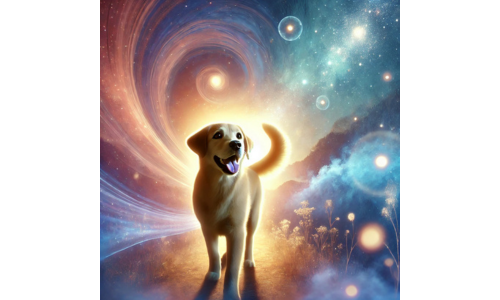Have you ever noticed your dog wagging their tail while deep in sleep? It’s one of those heartwarming and puzzling moments that make you wonder what’s going on in their dream world. Dogs experience various sleep cycles, just like humans, and their tail movements during sleep might hold clues about their subconscious activity.
While tail wagging is typically associated with excitement or communication during waking hours, in sleep, it takes on a different meaning. Understanding why dogs wag their tails in their sleep can give us valuable insights into their emotions, dreams, and overall well-being.
In this article, we’ll dive into the fascinating language of tail wagging, explore canine sleep cycles, and uncover why your furry friend might be wagging their tail in dreamland. Let’s unravel this adorable mystery together!

Why Dogs Wag Their Tail In Sleep?
If you’ve noticed your furry friend wagging their tail while snoozing, you might wonder what’s happening in their dream world. Tail-wagging during sleep is a fascinating behavior that provides insights into a dog’s emotional and neurological state. It’s not only adorable but also a sign that your dog’s brain is actively processing emotions and memories, even while they rest.
Dogs wag their tails in sleep primarily because they are dreaming. Like humans, dogs go through Rapid Eye Movement (REM) sleep, a phase where brain activity increases, and dreams occur. During this phase, your dog may relive joyful moments, exciting adventures, or even playful interactions with you. The tail-wagging reflects their emotional response to the dream, which is often positive.
Another reason could be muscle twitches during REM sleep. As the body relaxes but the brain remains active, small movements like tail-wagging, paw twitching, or even soft barks can happen. These involuntary actions are normal and show that your pup’s brain is processing daily experiences, making sleep a vital part of their overall well-being.
So, the next time you catch your dog wagging their tail in their sleep, take it as a heartwarming sign, they’re likely dreaming of something that makes them happy!
Read More: Doppelganger Dream Meaning
The Language of Tail Wagging
Tail wagging is one of the most expressive forms of communication in dogs, conveying a range of emotions from joy and excitement to nervousness and submission. While it’s easy to recognize a wagging tail as a sign of happiness when your dog is awake, this behavior during sleep has a different significance.
When dogs wag their tails in their sleep, it’s often an extension of their subconscious emotions. The direction and intensity of the wag might indicate the type of dream they’re experiencing. For instance, a gentle wag may signal contentment, while a faster, more energetic wag could reflect an exciting or playful dream. Sleep-related tail wagging is not voluntary; it’s a physical manifestation of their dream world, similar to humans talking or moving slightly while dreaming.
This behavior also hints at your dog’s emotional well-being and bond with you. A relaxed, wagging tail while sleeping often means they feel safe and secure in their environment, reinforcing the trust they have in their surroundings.
Understanding Canine Sleep Cycles
To understand why dogs wag their tails in their sleep, it’s essential to know how their sleep cycles work. Dogs experience two main stages of sleep: slow-wave sleep (SWS) and rapid eye movement (REM) sleep. While SWS is a lighter stage where the body starts to relax, REM is the deeper stage where most dreaming occurs.
During REM sleep, a dog’s brain activity increases, resembling the level of activity they have when they’re awake. This is when vivid dreams take place, often reflecting moments from their daily lives playing fetch, chasing squirrels, or enjoying a treat. Tail wagging, twitching, or soft vocalizations occur as their body responds to these dream scenarios.
Interestingly, puppies and senior dogs tend to have more pronounced movements during sleep. Puppies, in particular, process new experiences and learning, which may result in more frequent tail wagging and twitching during dreams.
By understanding these sleep cycles and behaviors, you gain a window into your dog’s emotional and physical health, making tail wagging during sleep even more fascinating.
Learn More: Cheetah In Dream Meaning
Why REM Sleep Is Essential for Dogs?
REM (Rapid Eye Movement) sleep plays a crucial role in a dog’s overall health and well-being. Just like humans, dogs experience REM sleep as a deep stage of rest where the brain processes emotions, consolidates memories, and rejuvenates the body. During this stage, their brain activity mirrors what it’s like when they are awake, making it the most mentally restorative phase of sleep.
For dogs, REM sleep is particularly important because it helps them process the events and activities of their day. Whether it’s learning new commands, encountering new environments, or just engaging in their daily routine, REM sleep ensures that their brain retains what they’ve experienced. Puppies, for instance, spend more time in REM sleep than adult dogs because they are constantly absorbing new information and need this time to process and grow.
Moreover, REM sleep supports emotional regulation. Without sufficient REM sleep, dogs may exhibit behavioral changes such as irritability, restlessness, or difficulty focusing during training. This underscores how vital uninterrupted sleep cycles are for their mental and emotional balance.
Why Might a Dog’s Tail Wag While Asleep?
A dog’s tail wagging during sleep is most commonly observed during the REM phase when vivid dreams occur. This involuntary movement is often tied to the dreams they are experiencing, which might involve happy or exciting scenarios like playing with their favorite toy, greeting a loved one, or chasing a squirrel.
Tail wagging during sleep is a physical manifestation of their dream state. It’s their body’s way of expressing what’s happening in their subconscious mind. The tail movements could vary depending on the emotional tone of the dream—a slow wag might indicate a calm and content dream, while a fast wag could suggest an enthusiastic or playful dream sequence.
In addition to dreams, the tail wagging could also be a reflection of muscle relaxation and reflexive activity during REM sleep. While the brain is highly active during this stage, the body’s larger muscles are mostly relaxed, allowing smaller, repetitive movements like tail wagging or paw twitching to occur without interruption.
Ultimately, a wagging tail during sleep is a sign of a healthy and relaxed dog. It reflects not just their physical comfort but also their emotional state, indicating that they feel safe and content in their environment.
Final Words
Watching your dog wag their tail in their sleep is both endearing and fascinating. It’s a gentle reminder of the complex inner world our canine companions have, complete with dreams, emotions, and subconscious activity. Tail wagging during sleep is often linked to happy dreams, a sign that your dog is relaxed and content in their environment.
Understanding the role of REM sleep and how it contributes to your dog’s physical and emotional well-being offers deeper insight into their behavior. Providing them with a safe, comfortable space to rest ensures they get the restorative sleep they need for a happy, healthy life.
So, the next time you see your dog’s tail wagging while they’re fast asleep, cherish the moment. It’s a beautiful glimpse into their dream world—a reflection of their joy, love, and the bond they share with you.
- What Does It Mean to Dream About Cookies? - August 6, 2025
- Can You Decode the Meaning Behind Dreams About Construction? - August 4, 2025
- What Does It Mean to Dream About Coffee? - July 31, 2025




